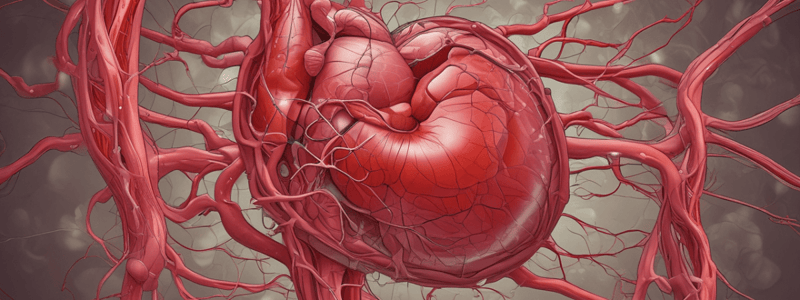Podcast
Questions and Answers
What is the mechanism of endothelial damage caused by hypertension in atherosclerosis?
What is the mechanism of endothelial damage caused by hypertension in atherosclerosis?
- Stimulation of proliferation and migration of smooth muscle cells
- Uncertain mechanism (correct)
- Direct pressure-induced damage
- Increased permeability to lipoproteins
Which of the following is a risk factor for atherosclerosis that is also associated with high risk of cerebrovascular and peripheral vascular disease?
Which of the following is a risk factor for atherosclerosis that is also associated with high risk of cerebrovascular and peripheral vascular disease?
- Hypertension
- Lack of exercise
- Diabetes mellitus (correct)
- Oral contraceptives
What is the role of macrophages in atherosclerosis?
What is the role of macrophages in atherosclerosis?
- Produce intercellular matrix
- Stimulate proliferation and migration of smooth muscle cells
- Oxidise LDL and take up lipids to become foam cells (correct)
- Synthesise collagen and proteoglycans
Which of the following is a microscopic feature of atherosclerosis?
Which of the following is a microscopic feature of atherosclerosis?
What is the role of platelets in atherosclerosis?
What is the role of platelets in atherosclerosis?
Which of the following infections is a risk factor for atherosclerosis?
Which of the following infections is a risk factor for atherosclerosis?
What is the role of endothelial cells in atherosclerosis?
What is the role of endothelial cells in atherosclerosis?
Which of the following is a clinical complication of atherosclerosis?
Which of the following is a clinical complication of atherosclerosis?
What is the characteristic feature of a fatty streak in atherosclerosis?
What is the characteristic feature of a fatty streak in atherosclerosis?
Which of the following is a non-modifiable risk factor for atherosclerosis?
Which of the following is a non-modifiable risk factor for atherosclerosis?
What is the primary component of fibro-fatty plaques in atherosclerosis?
What is the primary component of fibro-fatty plaques in atherosclerosis?
What is a clinical complication of atherosclerosis?
What is a clinical complication of atherosclerosis?
What is an early microscopic feature of atherosclerosis?
What is an early microscopic feature of atherosclerosis?
What is the primary mechanism of the response to injury hypothesis in atherosclerosis?
What is the primary mechanism of the response to injury hypothesis in atherosclerosis?
Which of the following is a modifiable risk factor for atherosclerosis?
Which of the following is a modifiable risk factor for atherosclerosis?
What is the term used to describe the formation of atherosclerotic plaques?
What is the term used to describe the formation of atherosclerotic plaques?
What is the complication of atherosclerosis that can lead to myocardial infarction?
What is the complication of atherosclerosis that can lead to myocardial infarction?
What is the characteristic feature of a complicated plaque in atherosclerosis?
What is the characteristic feature of a complicated plaque in atherosclerosis?
Study Notes
Atherosclerosis
- Atherosclerosis is a type of arteriosclerosis, characterized by the accumulation of intracellular and extracellular lipid in the intima and media of large and medium-sized arteries.
- Does not affect veins or capillaries.
- Slowly progressive, build-up of fat (cholesterol) within the artery wall, characterized by intimal lesions called atheroma, atheromatous, or fibro-fatty plaques.
Pathogenesis of Atherosclerosis
- Response to injury hypothesis:
- Initiated by endothelial dysfunction
- Chronic inflammatory response - presence of macrophages
- Migration of smooth muscle cells (SMC) from media to intima
- Proliferation of SMC in intima
- Excess production of extracellular matrix (collagen and elastin)
- Enhanced lipid accumulation
- Two most important causes of endothelial dysfunction are:
- Hemodynamic disturbances (hypertension)
- Hypercholesterolemia
- Inflammation is also an important contributor
Macroscopic Features
- Fatty streak: yellow discoloration with no bulging (small accumulation of macrophages with fat inside)
- Simple plaque: raised yellow legion with irregular outline, large plaque present
- Complicated plaque: can end up with calcification and hemorrhage
Microscopic Features
- Early changes:
- Proliferation of smooth muscle cells
- Accumulation of foam cells
- Extracellular lipid
- Later changes:
- Fibrosis
- Necrosis
- Cholesterol clefts
- +/- inflammatory cells
- Disruption of internal elastic lamina
- Damage extends into media
- Ingrowth of blood vessels
- Plaque fissuring
Clinical Complications
- Progressive lumen narrowing due to high-grade plaque stenosis
- Acute atherothrombotic occlusion - due to the activation of the coagulation cascade
- Thrombus embolisation into the distal arterial bed
- Ruptured abdominal atherosclerotic aneurysm
- Myocardial infarction (heart attack), ischaemic heart disease (IHD)
- Cerebral infarction (stroke)
- Aortic aneurysms
- Mesenteric occlusion
- Peripheral vascular disease (gangrene of the legs)
Risk Factors
- Non-modifiable risk factors:
- Age
- Gender (women protected relatively before menopause)
- Genetic predisposition
- Modifiable risk factors:
- Hyperlipidaemia (high plasma cholesterol, LDL most significant, HDL protective)
- Cigarette smoking
- Alcohol (>5 units/day associated with increased risk of IHD)
- Infection (Chlamydia pneumoniae, Helicobacter pylori, Cytomegalovirus)
- Hypertension (mechanism uncertain, endothelial damage caused by raised pressure)
- Diabetes mellitus: associated with high risk of cerebrovascular and peripheral vascular disease
- Other risk factors:
- Lack of exercise
- Obesity
- Oral contraceptives
- Stress and personality type?
Prevention and Intervention
- Prevention:
- No smoking
- Reduce fat intake
- Treat hypertension
- Not too much alcohol
- Regular exercise/weight control
- Intervention:
- Stop smoking
- Modify diet
- Treat hypertension
- Treat diabetes
- Lipid-lowering drugs
Studying That Suits You
Use AI to generate personalized quizzes and flashcards to suit your learning preferences.
Related Documents
Description
This quiz covers the definitions and characteristics of arteriosclerosis, atherosclerosis, and related diseases affecting blood vessels. Learn about the differences and symptoms of these conditions.




